Oscillations | Physics - Long Questions and Answer | 11th Physics : UNIT 10 : Oscillations
Chapter: 11th Physics : UNIT 10 : Oscillations
Long Questions and Answer
Oscillations (Physics)
Long Answers Questions
1. What is meant by simple harmonic oscillation?. Give examples and explain why every simple harmonic motion is a periodic motion whereas the converse need not be true.
Simple
harmonic motion:
●
The acceleration or force on the particle is directly proportional to its
displacement from a fixed point and is always directed towards that fixed
point.
●
In one dimensional case, let x be the displacement of the particle and ax
be the acceleration of the particle,
●
ax ∝ x
: ax = − b x where b is a constant which measures
acceleration per unit displacement and dimensionally it is equal to T−2.
●
By multiplying by mass of the particle on both sides of equation and from
Newtons second law, the force is Fx = − kx where k is
a force constant which is defined as force per unit length.
●
The negative sign indicates that displacement and force (or acceleration) are
in opposite directions.
●
When the displacement of the particle is taken towards right of equilibrium
position (x takes positive value), the force (or acceleration) will point
towards equilibrium (towards left) and similarly, when the displacement of the
particle is taken towards left of equilibrium position (x takes negative
value), the force (or acceleration) will point towards equilibrium (towards
right).
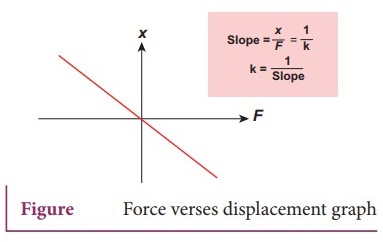
●
This type of force is known as restoring force because it always directs the
particle executing simple harmonic motion to restore to its original
(equilibrium or mean) position.
●
This force (restoring force) is central and attractive whose center of attraction
is the equilibrium position.
●
In vector notation ![]() = − k
= − k![]() , where
, where ![]() is the displacement
of the particle from the chosen origin.
is the displacement
of the particle from the chosen origin.
●
The exponent of force ![]() and the exponent of displacement
and the exponent of displacement ![]() are
unity.
are
unity.
2. Describe Simple Harmonic Motion as a projection of uniform circular motion.
●
Consider a particle of mass m moving with uniform speed v along the
circumference of a circle whose radius is r in anti-clockwise direction .
●
If ω is the angular velocity of the particle and θ the angular displacement of
the particle at any instant of time t, then θ = ωt.
●
Consider a spring mass system (or oscillation of pendulum). When the spring
moves up and down (or pendulum moves to and fro), the motion of the mass or bob
is mapped to points on the circular motion.
●
If a particle undergoes uniform circular motion then the projection of the
particle on the diameter of the circle (or on a line parallel to the diameter)
traces straight line motion which is simple harmonic in nature.
●
The circle is known as reference circle of the simple harmonic motion. The
simple harmonic motion can also be defined as the motion of the projection of a
particle on any diameter of a circle of reference.
3. What is meant by angular harmonic oscillation?. Compute the time period of angular harmonic oscillation.
●
When a body is allowed to rotate freely about oscillation is known as the
angular oscillation. The point at which the resultant torque acting on the body
is taken to be zero is called mean position.
●
If the body is displaced from the mean position, then the resultant torque acts
such that it is proportional to the angular displacement and this torque has a
tendency to bring the body towards the mean position.
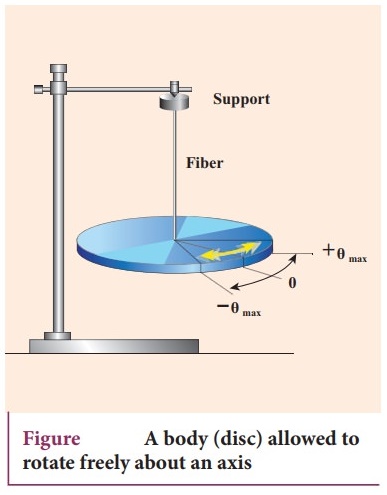
●
Let![]() be the angular displacement of the body and the resultant torque
be the angular displacement of the body and the resultant torque ![]() , acting on the body is
, acting on the body is
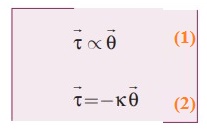
●
k is the restoring torsion constant, which is torque per unit angular
displacement. If I is the moment of inertia of the body and ![]() is the angular acceleration then
is the angular acceleration then
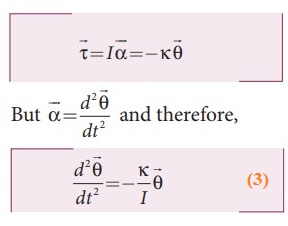
●
This differential equation resembles simple harmonic differential equation. So,
comparing equation with simple harmonic motion given in equation.
 …………..
(4)
…………..
(4)
The
frequency of the angular harmonic motion is  ………………(5)
………………(5)
and
the time period of the oscillation is  .
.
4. Write down the difference between simple harmonic motion and angular simple harmonic motion.
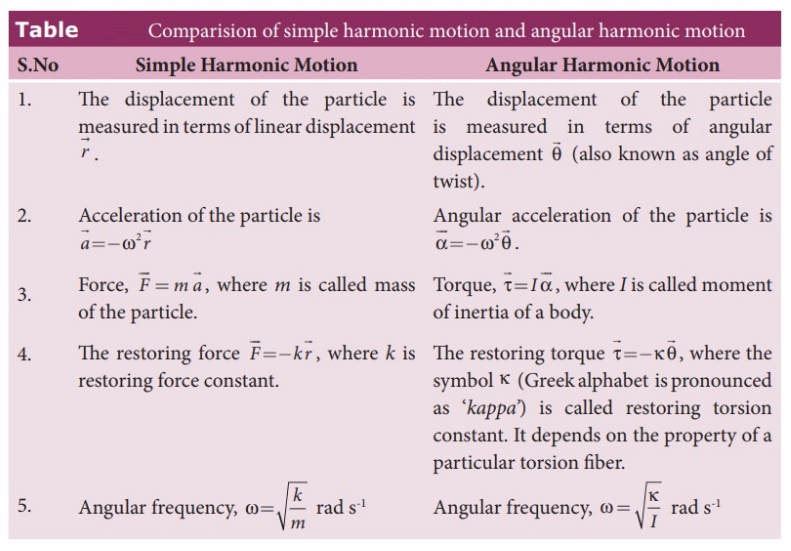
5. Discuss the simple pendulum in detail.
●
A pendulum is a mechanical system which exhibits periodic motion. It has a bob
with mass m suspended by a long string (assumed to be mass less and
inextensible string) and the other end is fixed on a stand.
●
When a pendulum is displaced through a small displacement from its equilibrium
position and released, the bob of the pendulum executes to and fro motion.
●
Let l be the length of the pendulum
which is the distance between the point of suspension and the centre of gravity
of the bob.
●
Two forces act on the bob of the pendulum at any displaced position, (i) The
gravitational force acting on the body  which acts vertically
downwards, (ii) The tension in the string
which acts vertically
downwards, (ii) The tension in the string ![]() which acts along the string
to the point of suspension.
which acts along the string
to the point of suspension.
●
Resolving the gravitational force into its components:
(a)
Normal component: The component along the string but in opposition to
the direction of tension. Fas = mg cosθ.
(b)
Tangential component:
The
component perpendicular to the string i.e, along tangential direction of
arc of swing.
Fps
= mg sinθ.
●
The normal component of the force is,
T-
Fas = m (v2/l)
v- Speed
of bob
T
- mg cosθ = m (v2/l) ……….(1)
●
The tangential force is nothing but the restoring force.
Applying
newton's second law,
m
( d2s / dt2 ) + Fps = 0 ;
m ( d2s / dt2 ) = − Fps
m
( d2s / dt2 ) = − mg sinθ ……………(2)
●
Arc length, s = lθ ………… (3)
∴
d2s
/ dt2 = l ( d2θ
/ dt2 ) ……………. (4)
Substitute (4) in (2) we get
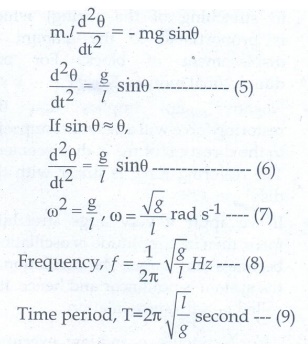
6. Explain the horizontal oscillations of a spring.
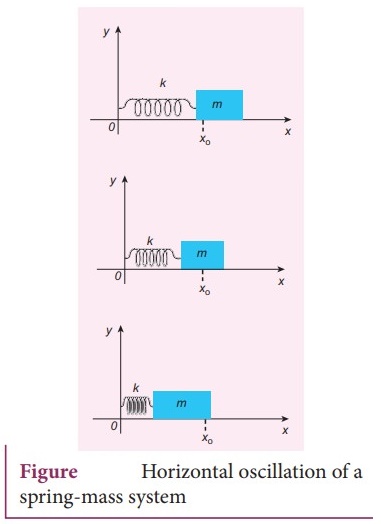
Horizontal
oscillation of a spring-mass system
●
Consider a system containing a block of mass m attached to a mass less spring
with stiffness constant or force constant or spring constant k placed on a
smooth horizontal surface (frictionless surface)
●
Let X0 be the equilibrium position or mean position of mass m when
it is left undisturbed.
●
Suppose the mass is displaced through a small displacement x towards right from
its equilibrium position and then released, it will oscillate back and forth
about its mean position X0.
●
Let F be the restoring force (due to stretching of the spring) which is
proportional to the amount of displacement of block. For one dimensional
motion. F ∝ x; F = −
k x
●
Negative sign implies that the restoring force will always act opposite to the
direction of the Y displacement. The restoring force is linear with the
displacement.
●
If we apply a very large stretching force, then the amplitude of oscillations
becomes very large. The oscillation of the system is not linear and hence, it
is called non-linear oscillation.
●
From Newton's second law. executing simple harmonic motion, is given by for the
particle.
m
[ d2x / dt2 ] = − kx ;
d2x
/ dt2 = − [k/m] x ……….(1)
●
Comparing equation (1) with simple harmonic motion equation.
we
get ω2 = k / m
●
Which means the angular frequency or natural frequency of the oscillator is
 ……… (2)
……… (2)
●
Natural frequency of the oscillator is
 ………. (3)
………. (3)
●
Time period of the oscillation is
 ………..(4)
………..(4)
●
In simple harmonic motion, the time period of oscillation is independent of
amplitude. This is valid only if the amplitude of oscillation is small.
7. Describe the vertical oscillations of a spring.
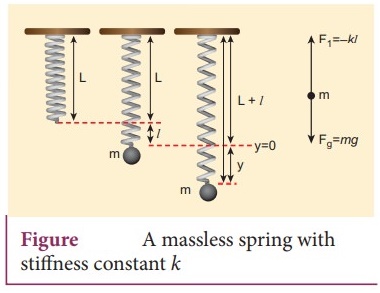
A
massless spring with stiffness constant k
●
Consider a mass-less spring with stiffness constant or force constant k
attached to a ceiling. Let the length of the spring before loading mass m be L.
If the block of mass m is attached to the other end of spring, then the spring
elongates by a length l
●
Let F1 be the restoring force due to stretching of spring. Due to mass m, the
gravitational force acts vertically downward. When the system is under
equilibrium. F1 + mg = 0 …………. 1
●
But the spring elongates by small displacement I1
therefore,
F1
∝ l ⇒ F1 = − kl ………. (2)
Substituting
equation (2) in equation (1). we get − kl + mg = 0
mg
= kl or m / k = l / g ……………… 3
●
Suppose we apply a very small external force on the mass such that the mass
further displaces downward by a displacement y. then it will oscillate up and
down. The restoring force due to this stretching of spring (total extension of
spring is (y + l) is F2 ∝ (y + l)
F2
= − k(y + l) = − ky – kl
….. (4)
By
drawing the free body diagram for this case, we get
−
ky − kl + mg = m (d2y / dt2
) …………..(5)
The
net force acting on the mass due to this stretching is F = F2 + mg
F
= − ky − kl + mg ……….. (6)
●
The gravitational force opposes the restoring force. Substituting equation (3)
in equation (6), we get
F
= − ky − kl + kl = − ky
Applying
Newton's law, we get
m
[d2y / dt2 ] = −ky
d2y
/ dt2 = [k / m] y ………….(7)
●
The above equation is in the form of simple harmonic differential equation.
The
time period as  second
second
●
The time period can be rewritten using equation (3)

The
acceleration due to gravity g can be computed from the formula g = 4π2(l/
T2)ms-2
8. Write short notes on the oscillations of liquid column in U-tube.
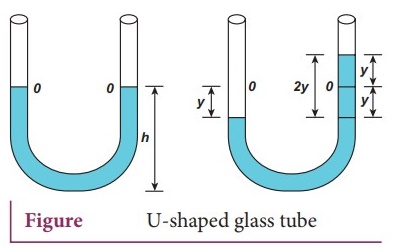
U-shaped
glass tube
●
Consider a U-shaped glass tube which consists of two open arms with uniform
cross-sectional area A.
●
Let us pour a non-viscous uniform incompressible liquid of density ρ in the
U-shaped tube to a height h
●
If the liquid and tube are not disturbed then the liquid surface will be in
equilibrium position O.
●
It means the pressure as measured at any point on the liquid is the same and
also at the surface on the arm (edge of the tube on either side), which
balances with the atmospheric pressure.
●
Due to this the level of liquid in each arm will be the same. By blowing air
one can provide sufficient force in one arm, and the liquid gets disturbed from
equilibrium position O, which means, the pressure at blown arm is higher than
the other arm.
●
This creates difference in pressure which will cause the liquid to oscillate
for a very short duration of time about the mean or equilibrium position and
finally comes to rest.
● Time period of the oscillation is

9. Discuss in detail the energy in simple harmonic motion.
a.
Expression for Potential Energy
●
For the simple harmonic motion, the force and the displacement are related by
Hooke's law 
●
Since force is a vector quantity in three dimensions, it has three components.
Further, the force in the above equation is a conservative force field; such a
force can be derived from a scalar function which has only one component.
●
In one dimensional case F = − kx
………… (1).
●
The work done by the conservative force field is independent of path.
●
The potential energy U can be calculated from the following expression.
F
= − dU / dx …………(2)
Comparing
(1) and (2). we get
−
dU/dx = − kx ; dU = kxdx
●
This work done by the force F during a small displacement dx stores as
potential energy
 ………. (3)
………. (3)
From
equation 
Substitute
the value of force constant k = mω2 in equation (3).
We
get U(x) = 1/2 mω2x2
●
Where ω is the natural frequency of the oscillating system. For the particle
executing simple harmonic motion from equation x = A sin ωt. we get
U(t)
= 1/2 mω2A2Sin2ωt ………… (4)
b.
Expression for Kinetic Energy
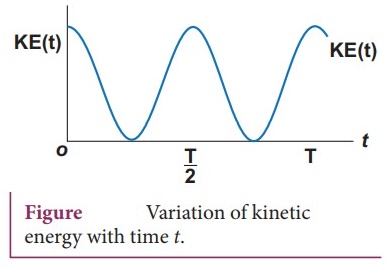
Kinetic
energy KE = 1/2 mvx2 = 1/2 m(dx/dt)2
Since
the particle is executing simple harmonic motion,
x
= A sin ωt Therefore.
Velocity
is vx. = dx / dt = A ω cos(ωt)

Hence.
KE = 1/2 mvx2 = 1/2 mω2 (A2 – x2
) …….(6)
KE
= 1/2 mω2A2cos2ωt ………. (7)
c.
Expression for Total Energy
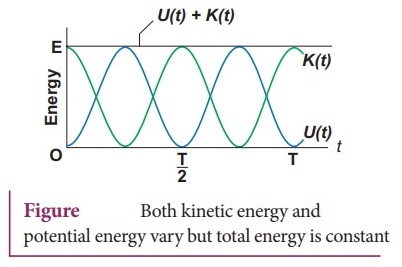
Total
energy is the sum of kinetic energy and potential energy E = KE + U …….. (8);
E
= 1/2 mω2 (A2 – x2 ) + 1/2 mω2x2
Hence
cancelling x2 term.
E
= 1/2 m ω2 A2 = Constant …………
(9)
From
equation (4) and equation (7).
We
get the total energy as
E
= [ 1/2 m ω2 A2 Sin2ωt ] + [ 1/2 m ω2 A2
cos2ωt ]
E
= 1/2 m ω2 A2 ( Sin2ωt + cos2ωt)
From
trigonometry identity. (Sin2ωt + cos2ωt) = 1
E
= 1/2 m ω2 A2 = Constant.
This
gives the law of conservation of total energy. Thus the amplitude of simple
harmonic oscillator can be expressed in terms of total energy.

10. Explain in detail the four different types of oscillations.
Damped
oscillations:
●
During the oscillation of a simple pendulum, the amplitude of the oscillation
is constant and also the total energy of the oscillator is constant. In a
medium, due to the presence of friction and air drag, the amplitude of
oscillation decreases as time progresses.
●
The oscillation is not sustained and the energy of the SHM decreases gradually
indicating the loss of energy. The energy lost is absorbed by the surrounding
medium. This type of oscillatory motion is known as damped oscillation.
●
If an oscillator moves in a resistive medium, its amplitude goes on decreasing
and the energy of the oscillator is used to do work against the resistive
medium.
●
The motion of the oscillator is said to be damped and in this case, the
resistive force (or damping force) is proportional to the velocity of the
oscillator.
● Examples: (i) The oscillations of a pendulum (including air friction) or pendulum oscillating inside an oil filled container, (ii) Electromagnetic oscillations in a tank circuit, (iii) Oscillations in a dead beat and ballistic galvanometers.
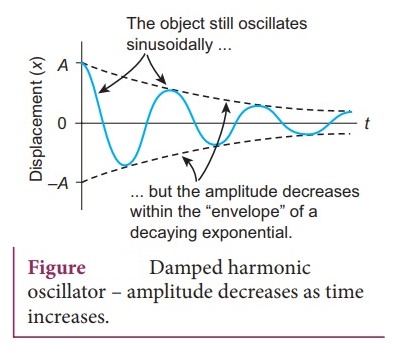
Maintained
oscillations:
●
While playing in swing, the oscillations will stop after a few cycles, this is
due to damping. To avoid damping we have to supply a push to sustain
oscillations.
●
By supplying energy from an external source, the amplitude of the oscillation
can be made constant. Such vibrations are known as maintained vibrations.
●
Example: The vibration of a tuning fork getting energy from a battery or
from external power supply.
Forced
oscillations:
●
Any oscillator driven by an external periodic agency to overcome the damping is
known as forced oscillator or driven oscillator.
●
In this type of vibration, the body executing vibration initially vibrates with
its natural frequency and due to the presence of external periodic force, the
body later vibrates with the frequency of the applied periodic force. Such
vibrations are known as forced vibrations.
●
Example: Sound boards of stringed instruments.
Resonance:
●
The frequency of external periodic force (or driving force) matches with the
natural frequency of the vibrating body (driven).
●
As a result the oscillating body begins to vibrate such that its amplitude
increases at each step and ultimately it has a large amplitude. Such a
phenomenon is known as resonance and the corresponding vibrations are known as
resonance vibrations.
●
Example: The breaking of glass due to sound.
Related Topics